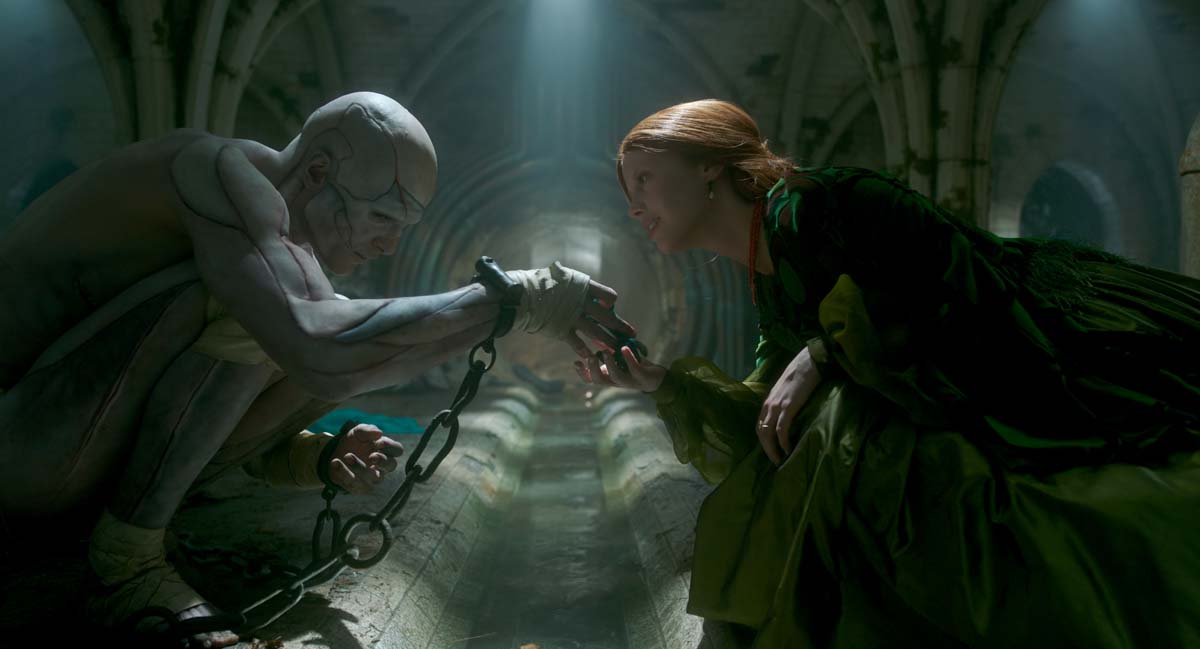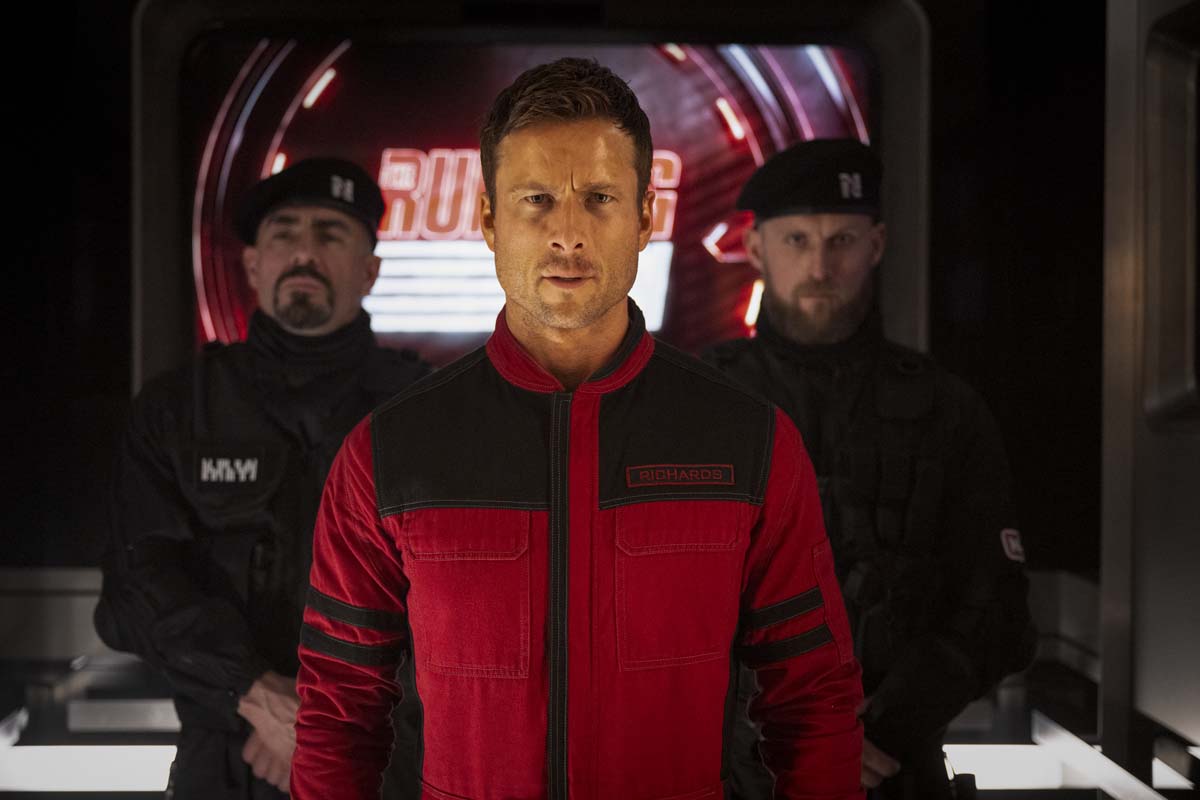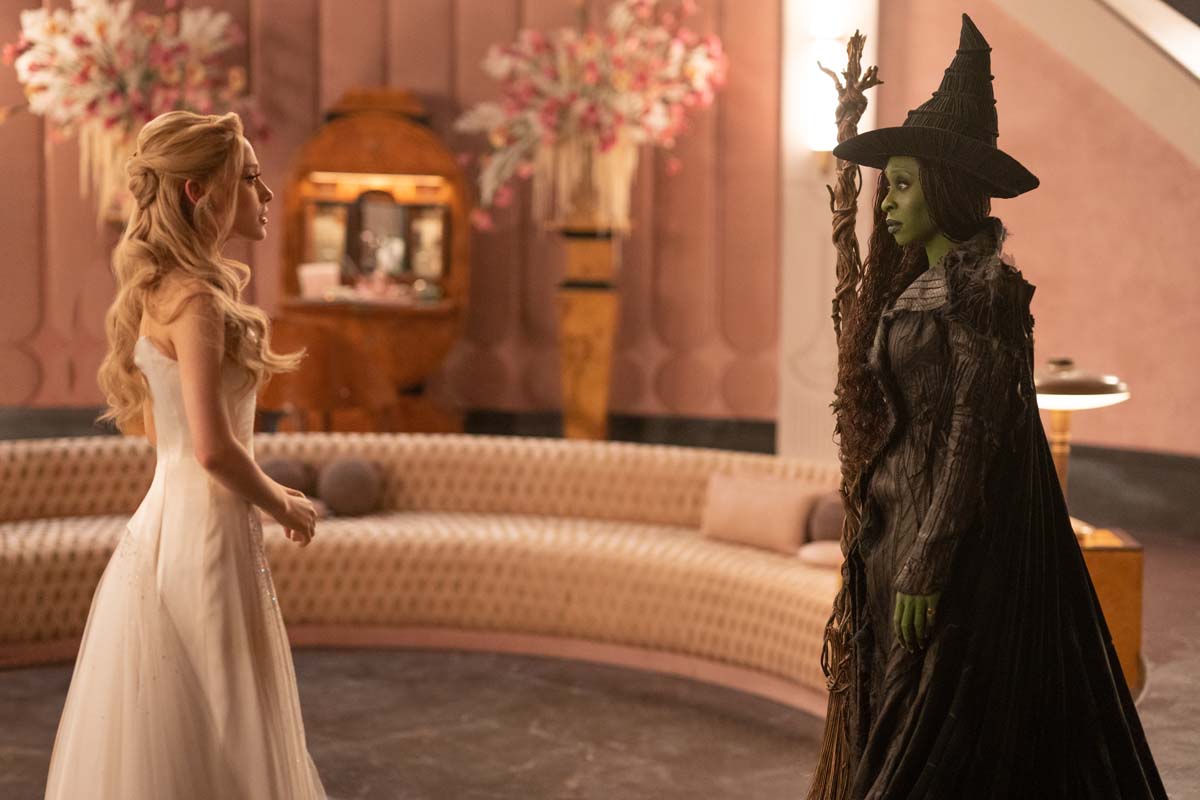Frankenstein
A discussion of the importance of editing speed while collaborating, the advantage of having the time for many screenings, and how being a “sound-aware editor” can shape the story.
Today, we’re talking to Evan Schiff, ACE about editing Guillermo del Toro’s Frankenstein which is available now on Netflix.
Evan’s feature editing career includes Nobody, Southside With You, John Wick Chapter 2 AND Chapter 3, and Birds of Prey, among others. If you want to follow him on Instagram:
Evan, it’s so nice to have you on Art of the Cut. We’ve done this before for a couple of movies, and I’m excited to talk about this one. I just got out of the theater from watching it and I am predicting a Best Picture for this.
That’s amazing. Thank you.
It is a stunning work of cinema. Congratulations on your part on it. Did you read the book to prepare for your interview with Guillermo?
I did as much research as I could do. I watched as many films as I could get my hands on. I read the script a bunch of times. I listened to an audiobook of the novel.
I got the Bernie Wrightson version of the paperback so that I could see the illustrations that he might be drawing inspiration from.
I did all of that prep, and, when I went in for my interview, Guillermo came out of the office and was on his way out the door and his assistant said, “You have an editor to interview.”
He looked down the hallway and said, “Evan. Yeah, yeah. You’re hired. You’re fast, right?” I said, “Yeah, I’m fast.” He said, “Yeah, yeah, this will be fun. See you later.” Then he left. I did all that work for nothing. It wasn’t for nothing, but I did it for the an interview that basically didn’t actually happen.
His assistant and I looked at each other like “That was it?” I called my agent afterward and asked, “Could you verify that is real?” I had been an assistant editor on Pan’s Labyrinth and Hellboy 2, so we knew each other. That was like 2006, 2008, so he knew me and that was enough.
One of the things I thought was so beautiful about the film is it felt like there was no coverage. It felt like every shot was meant to be at that exact moment, and you didn’t have anything to do.
I had a lot to do. But, one of the nice things about the way that Guillermo shoots is he shoots single camera, single unit the entire time.
The shoots run a little bit longer because of that - we have more shoot days than you might if you were doing two units or two cameras, but that means that every single shot has an intention.
He knows where he wants the shots to be, what he wants them to accomplish. It makes it easier when I’m watching the dailies to understand what the thought process was.
Our workflow on this was new for me. On Hellboy 2, when I was an assistant editor, he would come in to editorial every day, but it would be after the shoot, so we would have the whole day to digitize dailies and get familiar with them.
Bernat Vilaplana cut that, and I did sound and all the usual stuff. But on this, he wanted to walk onto set on Tuesday morning with a cut on his laptop of what he had shot on Monday.
The routine that we ended up getting into was that if crew call was 8 a.m., I would be in the office with my assistant editor at 4 a.m. and we would hurriedly load dailies in, and I would - as quickly as possible, within the span of about two hours - cut everything from the day before and he would walk in at 6 a.m.
He would look at what I’d done and either we would make changes to that assembly or - if I had done it correctly – he’d say, “Okay! That’s right.” Then we would sit down and spend those two hours working on the other things that we shot.
So I had a lot to do in a very short period of time every day. We did that for basically seven months straight. I would get those call sheets and see that crew call was 7:30 in the morning, so I’d set an alarm four hours earlier.
Because he shoots single camera, single unit, the amount of footage that we were getting was not unmanageable. It was just a lot to go through that process of: “What do I have? How do I put this together so that it makes sense in the span of two hours?”
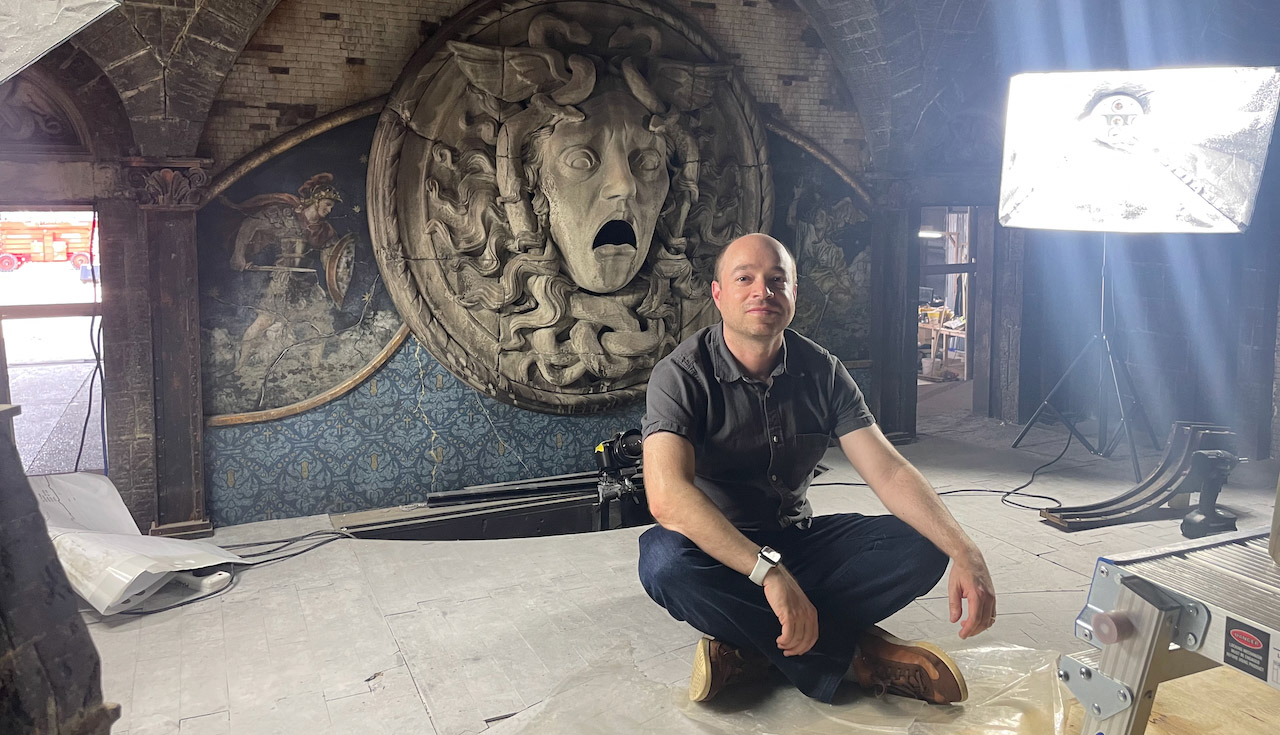
Editor Evan Schiff, ACE, on the miniature lab set
The shoot was divided up into two sections. There was the Toronto shoot - which was mostly on stages with a tiny little bit of shooting in the forest - then there was the Scotland shoot, which was a road trip over the course of six weeks in Scotland.
We were in a different city in Scotland and a couple in England every week. When we were in Toronto, we had Company 3’s Toronto location process dailies overnight. Those would usually arrive around 3 or 4 in the morning - just before we would get into the office.
The schedule in Toronto was a little bit more forgiving for my sleep and my call times because Jacob Elordi’s makeup (as The Creature) took so long to apply that they would have to give him an appropriate amount of turnaround at the end of the day.
If he was shooting multiple days in a row, that meant that on Monday, if we had an 8 a.m. call, then on Tuesday we might have a noon call, and on Wednesday we might have a 3:30 call in the afternoon, so that gave everybody a little bit more time. Jacob didn’t shoot all that much in the Scotland section.
In Scotland, we had somebody from Company 3 on location with us with one of those little carts going from hotel room to hotel room, so the timing was very tight.
She would receive the cards at wrap, then at around three in the morning, either a unit driver or I would stop by the lobby of her hotel and pick up a hard drive and drive it straight to set and load it in.

Evan cutting video assist in his hotel room in Scotland.
At the end of the Scotland shoot, I was feeling a little bit more time-crunched and I was exhausted, so I started cutting video assist. I would get video assists in a couple of drops throughout the day.
Then he would send the last couple of shots from the day when they wrapped with a unit driver to my hotel room and I would stay up and cut those so that by the time I got in the morning, I had an idea of what I needed to do and I would just overcut the actual rendered dailies.
It sounds like Guillermo’s question as he walked down the hall “Are you fast?” It sound like you needed to be.
He meant it. That continued all the way through post. When he asks for things, his mind is working so fast he wants to see it instantly, so you have to be very fast at the keyboard in front of him.
A few times during production he invited crew members to come in and watch us cut in the morning. At 6am sometimes 3 or 4 people from the crew would be hanging outside my office waiting for him to arrive, then he would usher them in and they’d sit down.
They wouldn’t generally say very much. They would just watch. Some of them would watch the client monitor that he was watching and some of them would come around behind my desk and watch what I was doing.
A couple of times crew members would say, “Wow, you have to be really on top of it when he’s in the room!” I would just say, “Yes! Yes I do!”
Let’s talk about the next part of the process then. You’ve finished cutting dailies. Then what happens and how do you work together?
My schedule was offset during the shoot. If the crew worked Monday to Friday, I was Tuesday to Saturday and we would use that Saturday all day to cut, so by the time that we wrapped - in terms of the state of the cut - we were far beyond a director’s cut.
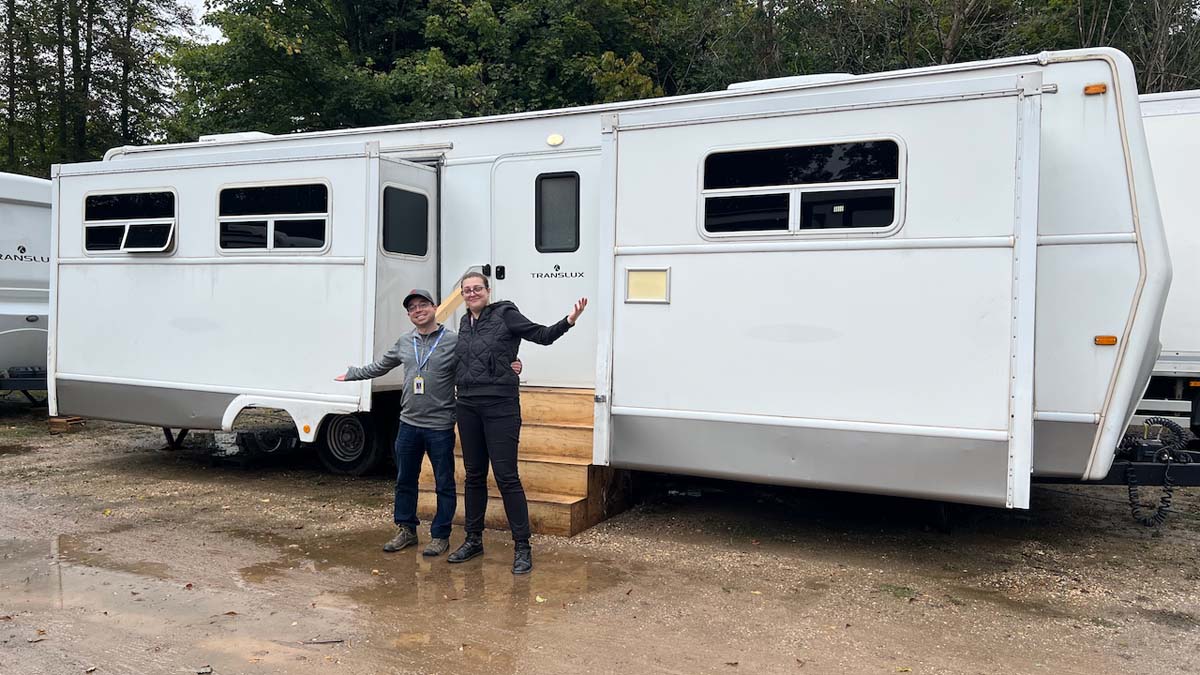
Evan and 1st AE Brit DeLillo on the last day of the shoot in Scotland
We got back to LA the first week of October 2024 and we were screening it fully - with temp VFX, sound, music, everything - three weeks later. On Hellboy 2 by the time that we finished shooting we had what I thought was a pretty advanced cut.
I think this was even more so. He loves to edit and he doesn’t see any benefit in waiting until the shoot is done to start making big decisions.
Sometimes we would shoot something on Monday, then on Wednesday we would turn it into a montage and half the material would disappear. He wasn’t precious.
Part of the reason that we gave him a full copy of the movie every day for his laptop is that he would be on set in between setups watching the movie and thinking about what he wanted to do the next morning, so we really were compressing the assembly and the director’s cut into the entire period of the shoot.
Can you talk about something that maybe was originally several scenes that was turned into a montage?
There was a montage where his task is to figure out how to make a body come to life, and he sends William to go get the tower and the lab ready.
Meanwhile, he’s flirting with Elizabeth and Harlander is getting impatient. That montage was originally kind of two montages separated by a couple of dialogue scenes.
The last shot of that montage of Elizabeth playing the piano used to be a whole separate thing, where the soundtrack to that montage was the sound of the piano piece that she’s playing.
Mia Goth (who played Elizabeth) learned to play that piece on the piano, and unfortunately, we didn’t use any of it, but we basically shot all of the pieces, and I assembled everything as it was scripted.
Then a day later, we decided there’s no point having two consecutive montages with these dialogue scenes in the middle that don’t give us all that much information.
So the dialogue scenes got folded into the montage and we just condensed everything into that one montage. We ended up cutting and recutting and recutting that section of the movie so many times during post-production.
I would say that was the area where - maybe because it was a last minute audible after we’d shot it - that we kept coming back to reassess “Is this doing what we need it to do?”

Edit trailer in England
Can you talk a little bit about your experience of the dailies and being able to see what he wanted to do: being able to look at a shot and say, “This is clearly the beginning, or this is clearly for this moment?”
When he shoots his coverage he’ll shoot a master all the way through several times and then he’ll go in for coverage and do sides.
There’s nothing unusual in the way that he does that, but there’s a lot of Steadicam, a lot of crane moves - things that are very directed. It’s not just a camera operator kind of adapting in real time to what the actors are doing.
Everything is planned and choreographed. For example, when Harlander is showing Victor the Evelyn table for the first time, there’s coverage of the two of them and overs and things like that but there’s a moment where there’s a very well-lit shot of Harlander’s hand going up to point out the lymph nodes that are on the Evelyn table. I can see that and tell: obviously this is the shot that he wants in this moment.
With like a dialogue scene there are infinite ways that you can cut it together, so I would have more room to play around with: “Who do I want to be on for this?
Do I want to be on dialogue? Do I want to be on the reaction?” There are specific things in terms of the blocking and how they move around the scene. You could understand, “Okay, because the actors are here, this is now the best angle in which I can view them.”

Avid timeline for “Frankenstein”
There are some really interesting score choices. For example, as the lab is being built and Victor and Elizabeth are capturing butterflies. Do you work typically with temp?
We did have temp. In Toronto there was a music editor named Radar who was on call for us. After we’d shot a month or two, we got to the point where we had some key scenes that we wanted to be able to use as showpieces for executives that were visiting or people that came to the cutting room.
We sent the whole movie at that point to Radar with direction from Guillermo about what he was thinking. So Radar did the first pass on a couple of months-worth of scenes - then using that as a template - Guillermo and I pretty much temped the rest of the film. We did that all the way through the Toronto shoot.
Then we got to London, which was where we did our miniature shoot. The thing that I learned about doing a miniature shoot for the first time is that it is very slow.
They spend all day setting up the shot for 4:30 in the afternoon. They shoot maybe one or two takes that last a couple of seconds, so we had all day - while they were setting up these miniature shoots - to edit.
At that point we took out all the temp, and for the next two months or so, we worked without temp in the cut. We did that in order to free ourselves from any decisions we might have made based off of the rhythm of the temp.
We knew that it was a long script. We didn’t want it to be an excessively long film, so we were really spending a lot of that time in that month reassessing decisions and trying to cut what we had shot so far down to size. Then our six week Scotland shoot started.
After we got back to L.A., we had the whole film assembled. We put some of the temp that we had had previously back in but we found a bunch more temp. I did basically all the temp music editing in post-production.
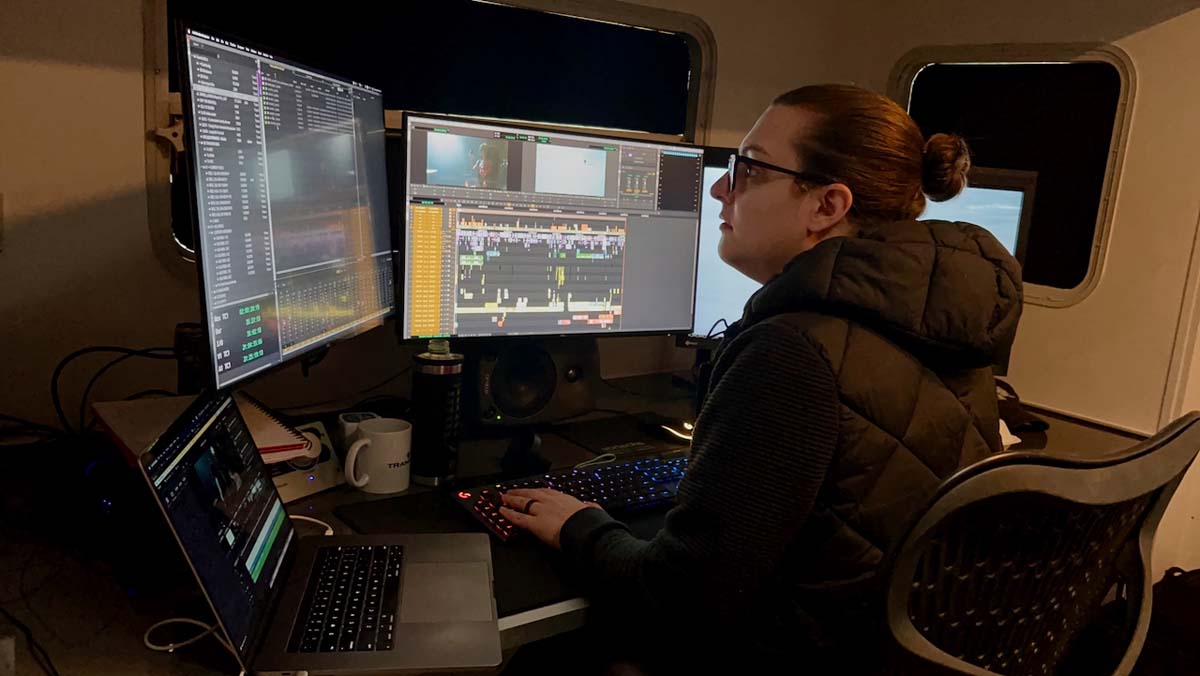
1st Assistant Brit DeLillo in the edit trailer in Scotland
At a certain point we invited some friends of Guillermo to screen the film and one of the notes that we got back was “Go bigger with the temp!” We thought, “You’re right!” I’m thinking of the tower explosion scene. The note was, “This needs to feel more dramatic.
It needs to feel bigger in the music. Music is holding us back right now.” So we found a much different cue - more symphonic - as opposed to some of the baroque temp that we had been using for Victor’s section earlier.
That helped a lot and made the movie feel much more dynamic. That was the temp that we screened with for a very long time until [composer Alexandre Desplat] started giving us demos and recordings.
When you’re temping things does Alexandre say, “I don’t think we need music here.” or “We should put some music here, even though you didn’t temp anything here.”?
He makes those decisions, but it’s less of a back and forth, or at least maybe with me. Alexandre lives in France, so a few times Guillermo went to France to work with him in person, but I think even in those sessions, Guillermo wasn’t really dictating to him the spotting.
We had done a spotting session with Alexandre in LA without playing him any of the temp that we had put in.
We went through and just said, “We have a cue from here to here, and this is sort of the emotion that we’re thinking.” Just very vague notes because Guillermo is very respectful of Alexandre’s process and Alexandre is also very specific about his process, which makes it great when everybody knows “this is how I want to work” and the other people say, “Great, we’re going to let you work that way.” Then everything is golden.
None of our turnovers to Alexandre had temp in them, so it really freed him to decide how he felt about where things should stop and start. As we started getting demos we would send notes back and say, “I think we need a cue that goes 10 seconds longer here” or “There’s nothing written in this moment, but we feel like we really need it.”
Then Alexandre would write something. So there was a little more back and forth there, but the importance of giving Alexandre the freedom to absorb the movie and decide what was speaking to him was something that we really wanted to preserve.
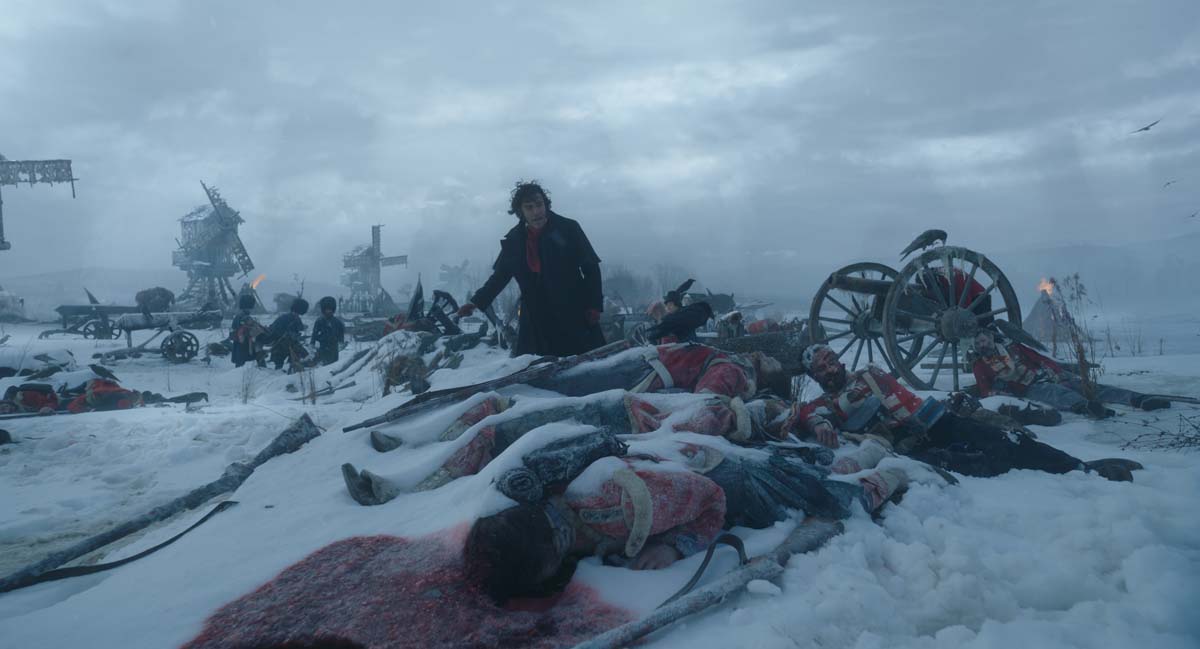
Victor Frankenstein (Oscar Issac) on the battlefield, harvesting body parts
I was interested in the score that’s under the post-battlefield dissections. Victor Frankenstein goes out on this battlefield and all these soldiers are dead, then he comes back with all these body parts. The score is really interesting under there. How did you temp that? Were you surprised or did it change your edit when Alexandre gave you his score?
So I have a musical background. I played piano for many, many years, so I enjoy music editing when I get a chance to do it. I also enjoy having a music editor who can do all of that for me when I’m really busy, but in this scene it was nice to get to flex those muscles for that sequence of the body assembly.
That was an area where – when I cut it together - I knew I couldn’t show it to Guillermo without temp. With everything else he said, “Show it to me without music. Let’s just look at it dry.”
But I needed to show that sequence to him with temp. So I found a waltz that Alexandre had composed for Crimson Peak, and it worked great.
That montage needed to feel operatic. It needed to feel like Victor was in his element. It needed to feel like this is an artistic moment, not a horror moment. He’s making something beautiful in that scene, and he’s having fun doing it, and the music needed to support that goal, so I put that waltz in there and it lived like that for a while.
We had another piece that somebody suggested that we put in there that was also a waltz that worked well. That was Jazz Suite No. 2 by Shostakovich. We went back and forth between those two pieces over the course of post-production.
They were very similar, but one of them was more fun and one of them hit the beats a little bit more in sync, so it just kind of depended on how we were feeling and who we were showing it to. Both lived in the timeline and we would just mute and unmute depending on the feeling of the day.

Then Alexandre delivers this amazing cue that is a waltz, but it’s also weird and quirky in a way that our temp had not conveyed in any sense and just 100% fit.
We did not adjust the cut of that after Alexandre delivered that because he had done such a specific composing job it that to change the cut after that would have been destructive.
What do you think the reason is that a waltz worked so well for that piece.
It’s the first moment in the film where you see Victor relaxed. He’s in his moment. It’s almost like he put some headphones on and just thought, “It’s time to do this!”
It’s sort of a montage of a dance of body parts being assembled, so I think the waltz really works on that level. It’s big and it’s grandiose. It was the first instinct that I had, and it worked.
It’s very propulsive. He’s sliding ice blocks and dragging body parts and he’s in constant motion. It’s a very motion-driven scene.
It’s very physical. And it’s the beginning of a whole propulsive section leading into Harlander revealing why he asks Victor to do this in the first place.
Leading into the creation scene and the lightning, then going into the creature’s body I feel like that body assembly montage really gets you in the mood for everything that then comes in the five minutes after that.
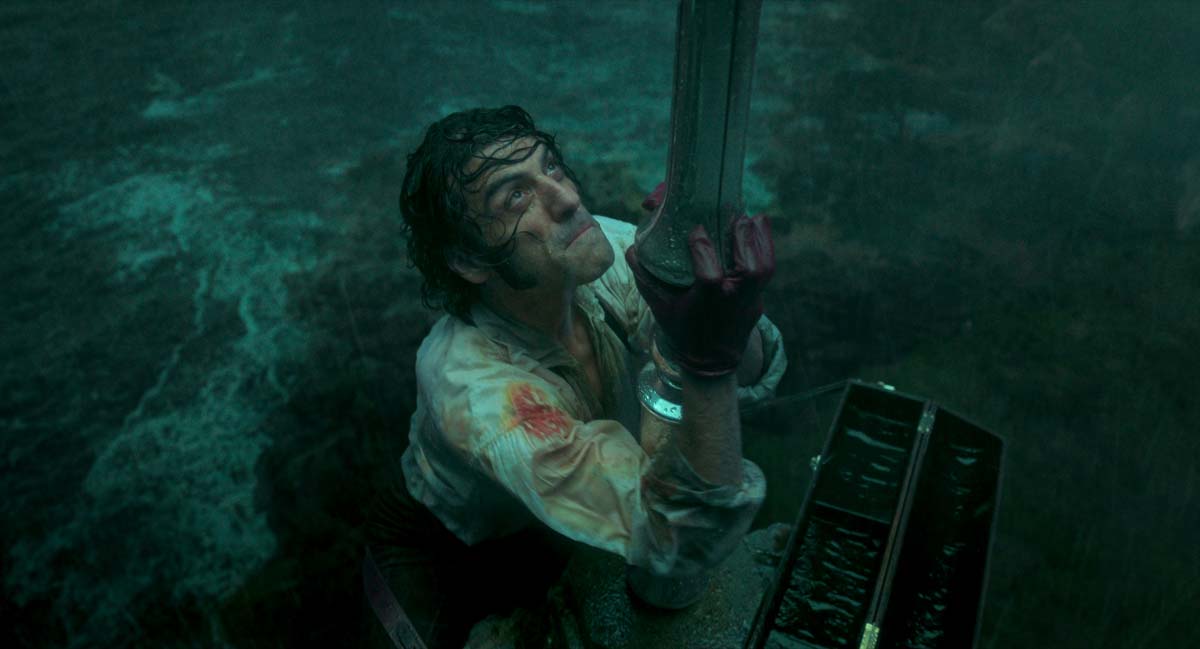
Talk about building the tension of the storm scene.
That was an area that we kept revisiting. Victor climbing up and putting the rod on top of the tower, which looked precarious in the dailies even before we removed all of the wires and put him much higher above the ground in Scotland. I think that did a good job of establishing tension.
One slip of his glove and catastrophe. One of the things that we worked on throughout that sequence was “how close is the storm?” which is our ticking clock. Is Victor ready for it? The batteries start exploding. Things are going wrong.
Late in post-production - as happens on all Guillermo movies - we showed the film to Alfonso Cuarón. Alfonso is a very talented editor in his own right. We got on Zoom over the course of three days this past April (2025), and we cut with Alfonso virtually.
We just went very slowly through the film, and Alfonso had questions and notes and things. Sometimes he would want to make changes, and Guillermo would say, “I’m going to leave the room for 20 minutes. Do whatever you want.
I can’t watch you do this in real time.¨ Guillermo knew he needed to do it, but he didn’t want to see it happen. He just wanted to see the end result and decide whether he liked it.
One of Alfonso’s notes was that the lightning storm – as it approached - seemed predestined and there needed to be a little bit more of a moment of; ‘The storm is here. Everything’s set up, but the lightning still needs to hit in a very specific spot. Is it actually going to do that?”
So we went back to what we jokingly called “Seinfelds” which were the castle establishing shots from our miniature shoot. We shot exteriors of the miniature of the tower from a bunch of different angles at different times of day, not knowing exactly where we were going to put them in.
We added a couple of those into the sequence to give you a sense of how close the storm was and to see a lightning strike hit the top of the tower, but not the rod. Just adding those extra 10 or 15 seconds of Victor waiting to see, “Is this going to happen?” really helped sell it.
That whole sequence was really fun to put together, and getting those notes from Alfonso helped us really ratchet up the tension in a very useful way.
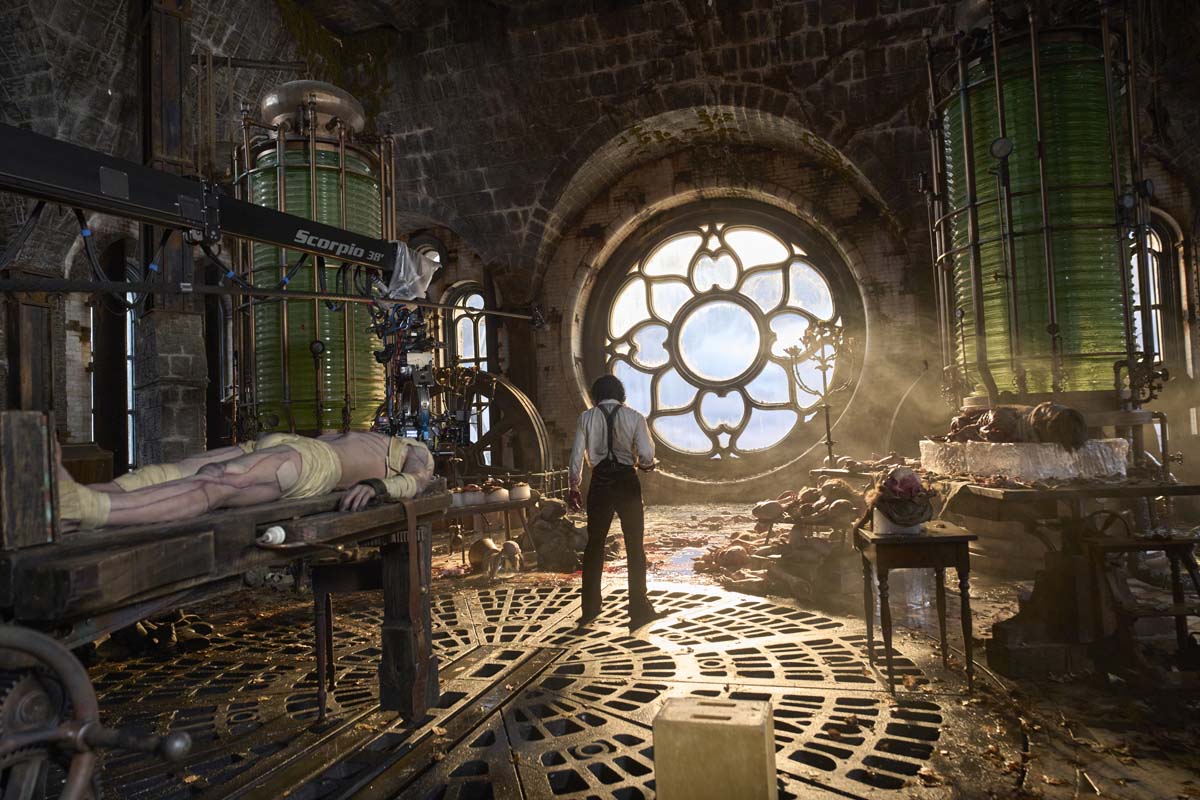
What was one of the biggest challenges of editing this film?
The progression of this story is atypical because we have what we think is our protagonist, that we start the movie with - Victor - and we go back to Victor’s childhood and we see how abusive his father was, how difficult of a relationship they had, how he lost his mother at a young age when his brother was born. We really establish your sympathy for Victor.
But by the end of the film, Victor is not really the protagonist anymore. He has crossed over into being the antagonist.
There was a constant push and pull over how do we accomplish that in a way that the audience will go along with?
How do we make sure that that Victor is likable when we want him likable and unlikable when we want him unlikable, but not so unlikable too early that you’re not invested in his success through the back half of his part of the film.
There are some things in Victor’s childhood that we cut out in order to make Victor a little bit more sympathetic.
Victor got a little bit darker in his childhood than what’s in the final film, but we got some feedback from some of Guillermo’s talented director friends that if Victor as a child was unlikable, then Victor as an adult would be starting off at a disadvantage.
That childhood was heavily tweaked in order to get the essential information that we needed an audience to have and the sympathy that we needed them to have for Victor, and understand why adult Victor is the way that he is because of these things that happened in his childhood without getting to the point where young Victor has already sort of pushed the audience over the edge.
There was always an imbalance naturally in the story between the Victor section and the Creature section because there’s so much more Victor story to tell - so much more time to cover for Victor’s life than there is for the creature’s story - but it still needs to feel kind of equally weighted in the end.
Initially there was a third title card that said “Fathers and Sons” - which separated the creature story from the last 30 minutes or so, but we took it out in order to keep momentum going and not stop everything with a card.
But by the time that we get to that moment where the creature reunites with Victor it needs to have felt like you had lived with the creature for a while as well. Those were the things that we are constantly reassessing and watching for and asking people about during post-production.

Cutting using video assist
Because we had this very advanced cut very early, we had the luxury of being able to show it to people, then take a week and make some changes, then show it to another couple of people and do that 10, 11, 12 times over the course of post. That was very useful for really dialing in who are we spending time with and how do we feel about them?
When the card came up to say we’re switching from Victor to the creature I thought, “Now we’re starting over…” Did you feel like you were under the gun to get us through that part of the story and back to Victor or back to the ship? Clearly, the creature part of the story is critical, but…
In screenings since the film has come out the audience has applauded at that card in multiple screenings that I’ve been to.
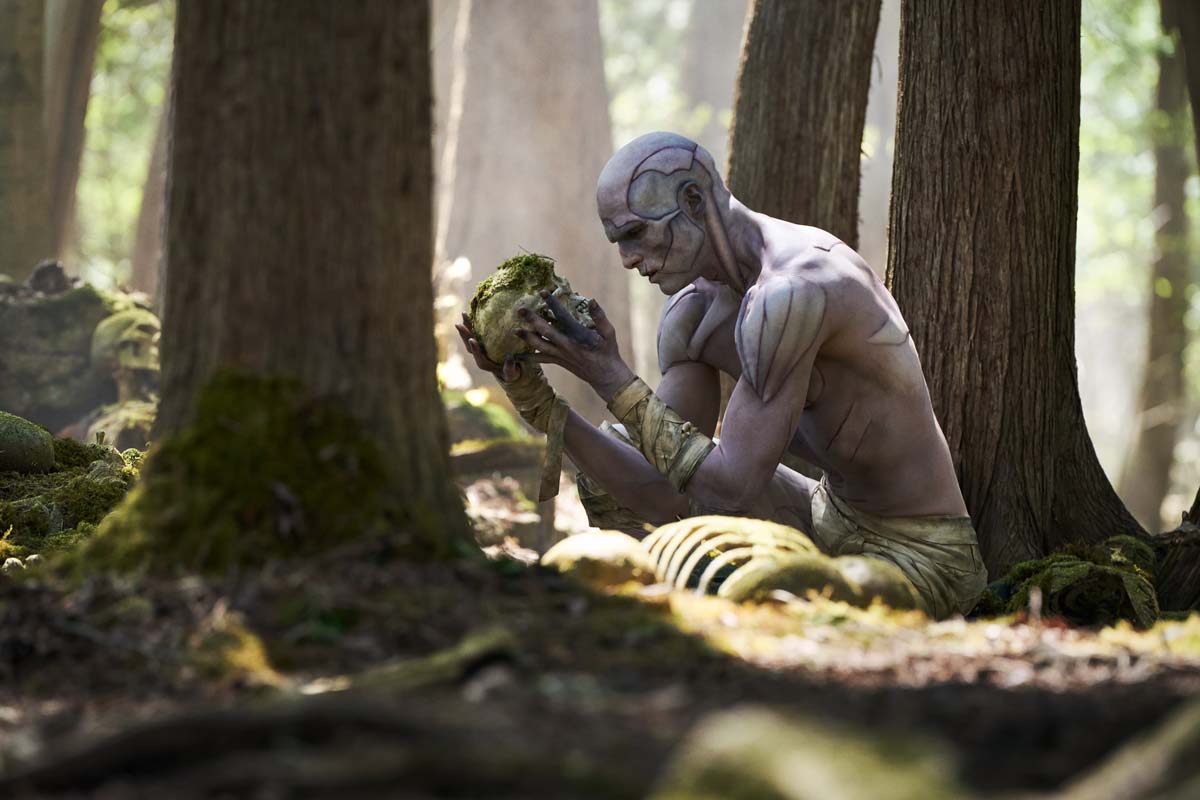
I love that reaction because I enjoyed the creature story more than the Victor story.
I think part of that is because he is so sympathetic. Jacob did such an amazing job inhabiting the creature and making you really feel for him and understand him and sympathize with him, but – intentionally - it’s a very different energy.
The Victor section has this constantly moving manic energy because Victor just can’t stop. But the creature is like, “I’m gonna examine this skull on the ground and, oh, look, there’s a jacket I’m going to pick up and oh, there’s a deer, let me feed the deer.”
It’s intentionally a moment to allow you to sit back and relax a little bit and absorb the world in the same way that the creature is doing.
One of the questions with the creature is: how far back do we go? We decided to start the creature’s section at the point where he needs to make his first independent decision, so that’s the point where he really starts telling his own story.
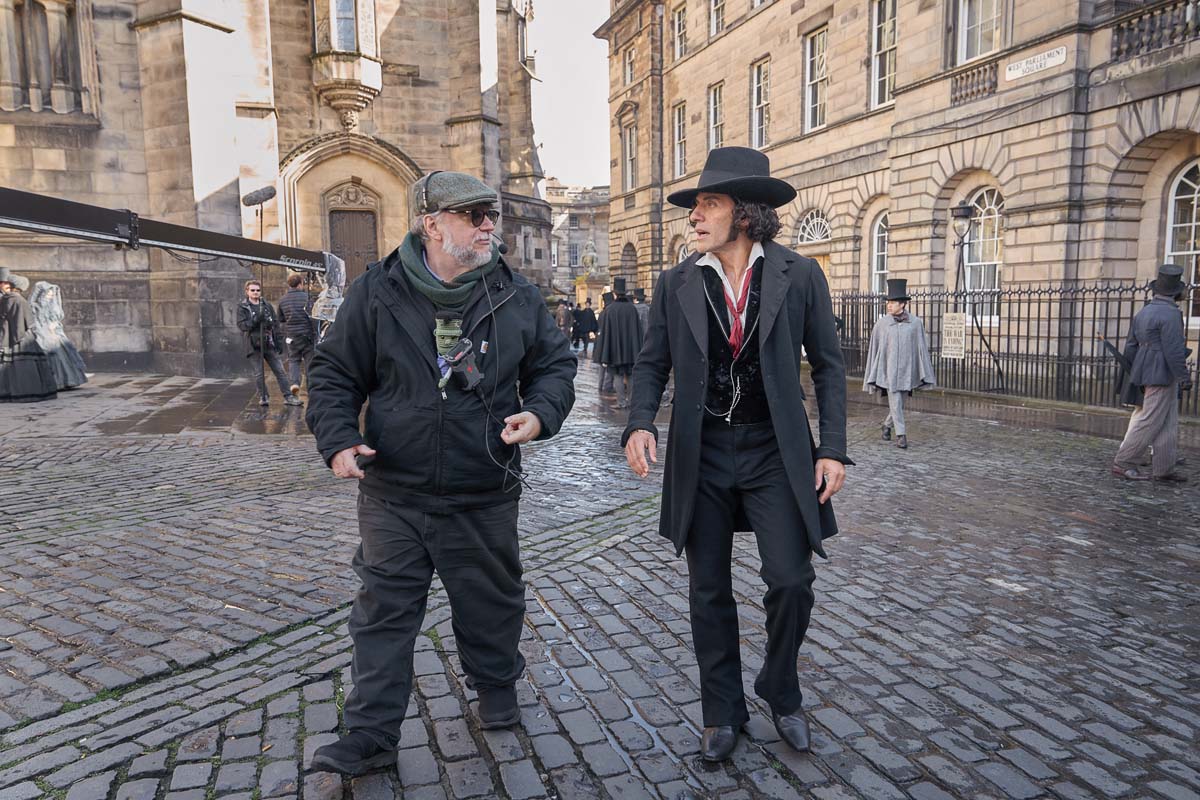
We accelerated that section, but we retold that brief moment of the tower exploding and the batteries falling, and everything from the creature’s point of view to get the sense of urgency so you’re not seeing too much of the same moments that you saw from Victor’s side.
I wouldn’t even call it a recap. It’s just a brief change of POV, then we’re off into the water and the forest.
In the beginning of the creature section were there any big “killing your darlings” moments other than changing scenes into montages and that kind of stuff?
In the scripted version of the film, young Victor kills his father. He has been harboring resentment for the death of his mother. He suspects that his father did not try as hard as he needed to in order to save his mother, and it’s been eating away at him so he decides to do something about it. This is where we get to the part that’s not in the movie.
He researches poisons. There’s this beautiful shot in a library in a house that we shot in Scotland, where he finds a volume that has a recipe for a poison, and he goes out and he gets one of the key ingredients from a lichen that’s growing on the side of his mother’s grave.
And while his father is sleeping, he sneaks into the bedroom with an eyedropper and puts a couple drops of this poison in his ear.
Then the next morning, they’re at breakfast eating their soft boiled eggs and Victor’s father starts to feel ill and looks over at his son and realizes he’s been poisoned and he sends a footman to get his medical bag, but it’s too late.
He stands up and there’s blood coming out of his nose and his ear and his skin goes pale and he’s clearly suffering.
He falls back in his chair and we cut to young Victor, who just takes another scoop of soft boiled egg and puts it into his mouth with this little smirk on his face.
Then we cut to the coffin with the father’s death mask and have the father’s funeral as that exists in the film.
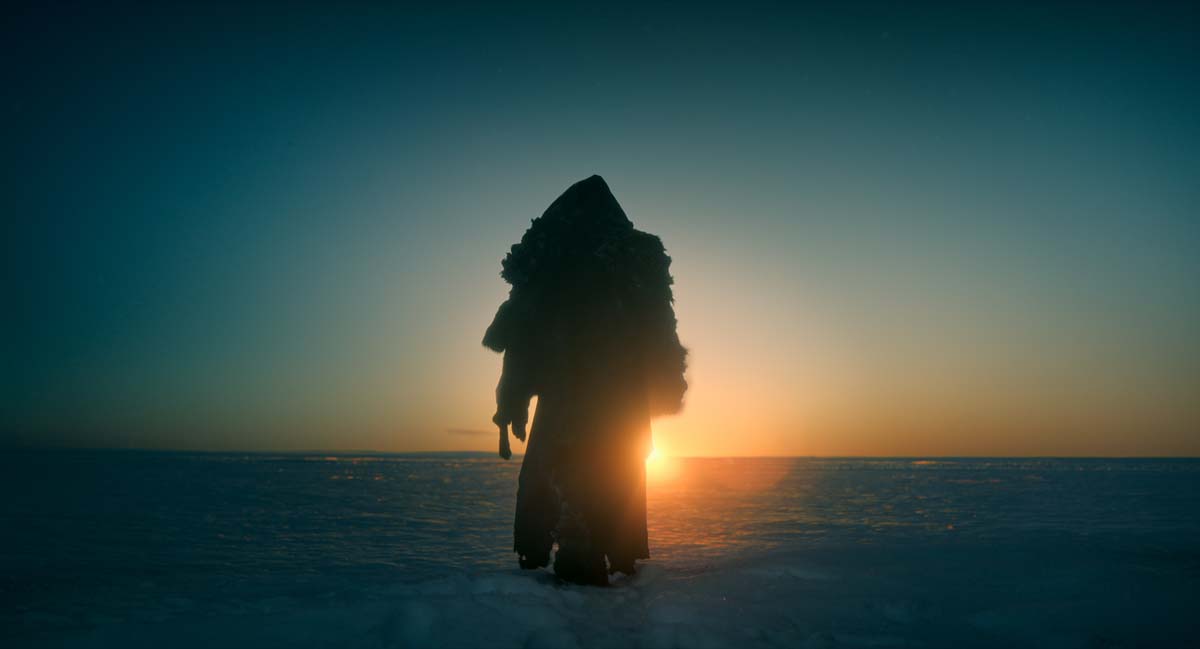
That sounds like an amazing scene. Talk to me about the creative choice that determined that it had to hit the cutting room floor.
That was an instance where if young Victor - at the age of 11 - is already a murderer, then adult Victor is irredeemable, but you need - as you’re going through adult Victor’s story - to be on that emotional journey with him.
He’s a man who’s full of hubris and ego and disregard for the consequences of his actions, but he can’t be a murderer. He can get there during the course of the story, but he can’t start there.
If he starts there, it changes your entire outlook about how you feel about him. We got that reaction from one of the screenings that we did. We got that reaction, we discussed it and we were very reticent to take it out, but we got the note, so let’s try it.
If we got the note or there was confusion we had to address it. We tried it and we thought about it and we lived with it and we thought, “The note is right. This is a problem and taking out the murder of Victor’s father is the solution.”
It reminds me of a lovely moment - kind of a “Save the Cat” moment - where Victor hears his name called out as the tower is burning, and he goes back.
Victor has a moment of second-guessing. With that, we debated, “Could Victor really hear the creature from that distance outside?”
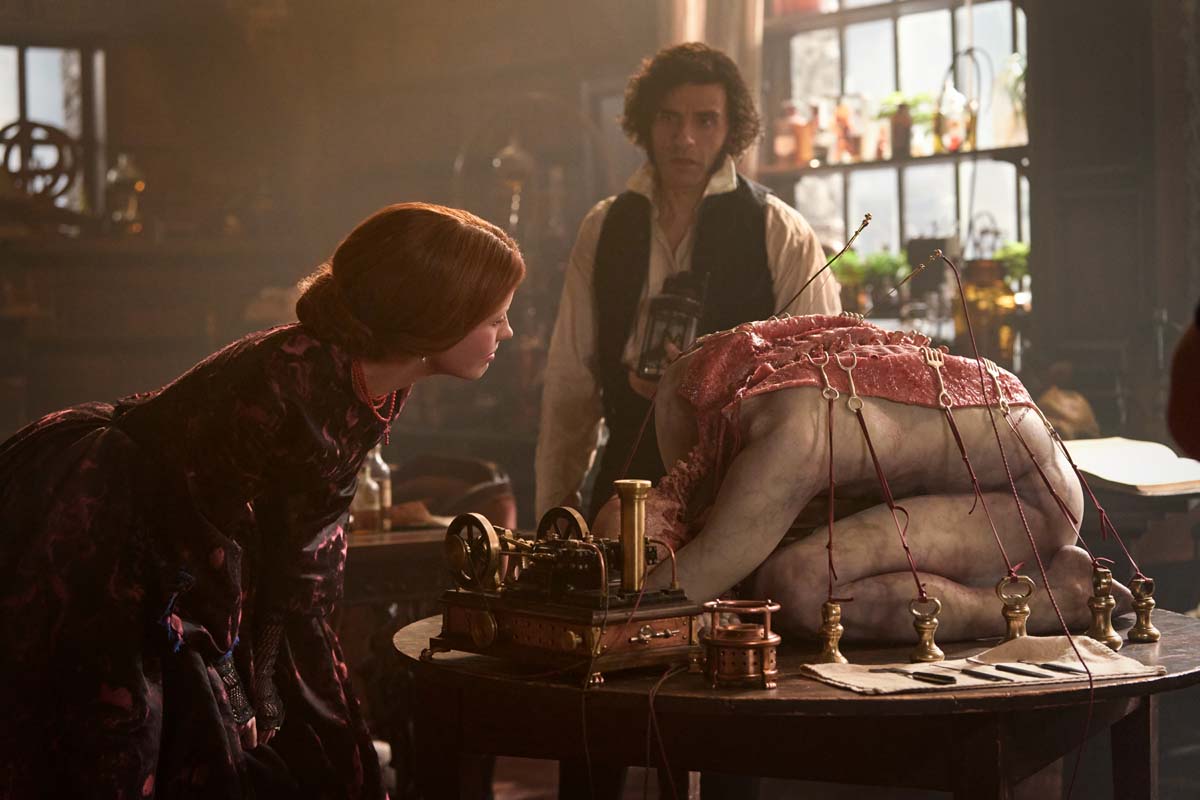
I never thought about that! It never even entered my mind. I was so into that moment.
I love those moments throughout the film where you see just a little bit of doubt creep in. There was an ending to that scene with William and Victor near the end of the film, where they’re in the bedroom, and William is telling Victor that he’s going to sell the estate and they’ll split the proceeds and just be done with this house.
Victor - at the end of the scene - used to get up and turn to William and say, “I want to tell you that I love you very much.” It was a nice, tender moment. That was definitely a thing that was in and out and in and out.
Guillermo and I disagreed on whether it should stay. I think I was arguing for it to stay in, and he said, “We don’t need it. We need the movie to keep going.”
You need those moments of Victor – like when he gets slapped by Elisabeth on her wedding day - to keep him human. Even really, really terrible people can still have a shred of doubt or a shred of decency.
So those moments for Victor, I really like where you think, “Maybe this is the time where somebody will get through to him” then, no, it’s not the time.

I love the fact that the movie ending is left a little open. Like, there can be Frankenstein 2.
I’ve had a couple people ask me, “So what’s the creature’s life like now?” I don’t know. He can clearly survive anywhere, so there’s an interesting thought experiment about where his life goes from here.
Guillermo wrote this. He directed it the way he wanted, yet when he saw the dailies and when you worked with him on the cut, was there something that he needed to change?
One thing about our process of cutting super early and him editing on set is that it leaves him a ton of flexibility.
He can change the shoot plan for that day. He can change the shoot plan for the day after. He can go home on the weekends and rewrite the pages for the following week.
Dan Laustsen, the cinematographer, would come in to the edit. Sometimes Oscar would come in to editorial for 10 or 15 minutes right before call time. If there was a pickup that we needed to do or something wasn’t quite working we would just fix it.
That allowed us - at the end of the shoot process - to not have any surprises. We didn’t get into post-production and realize, “This doesn’t work.” We had done all of that testing and all of that fixing during the shoot.
One instance was a very pivotal scene of forgiveness between the creature and Victor. We shot that whole scene in one day on the stage in Toronto. We put it together and it wasn’t emotionally as powerful as we needed it to be.
Oscar himself brought it up. You need to leave that scene feeling shaken! So we went back the next day and we got a little closer coverage - particularly, on Victor - and reshot the moments where the creature is forgiving Victor and Victor is apologizing.
That was definitely a scene that - had we waited to assess all of this until late - we would have been really missing the emotion and the heartbreak of that moment, but because we did the process that we did, we were able to pick it up the very next shoot day while we still had all the sets and the lighting and everybody was in the right headspace in terms of their performances.
Guillermo was very open with people coming into editorial. That included the cast, which is not often a thing that happens.
So, if one of our cast members was having trouble understanding a motivation for that scene or where their headspace would be, they could come in editorial and watch everything that we’d shot with them so far and all the scenes that they haven’t seen because they weren’t on set those days. That gave them the context to go forth on the shoot day and do what needed to be done.
Guillermo considers editing before the beginning of the next shoot day to be a non-negotiable tool. We met with other directors during post, and we would describe this process and they would say, “I just can’t focus my brain on post while I’m worrying about what’s shooting.” And Guillermo would say, “But you have to! That’s the only way to do it.”
I am not a morning person, but I had to become one for this movie. You can’t argue the value of it. It was just proven every single day the value of him being able to go to set with everything fully incorporated and cut already before shooting another day.
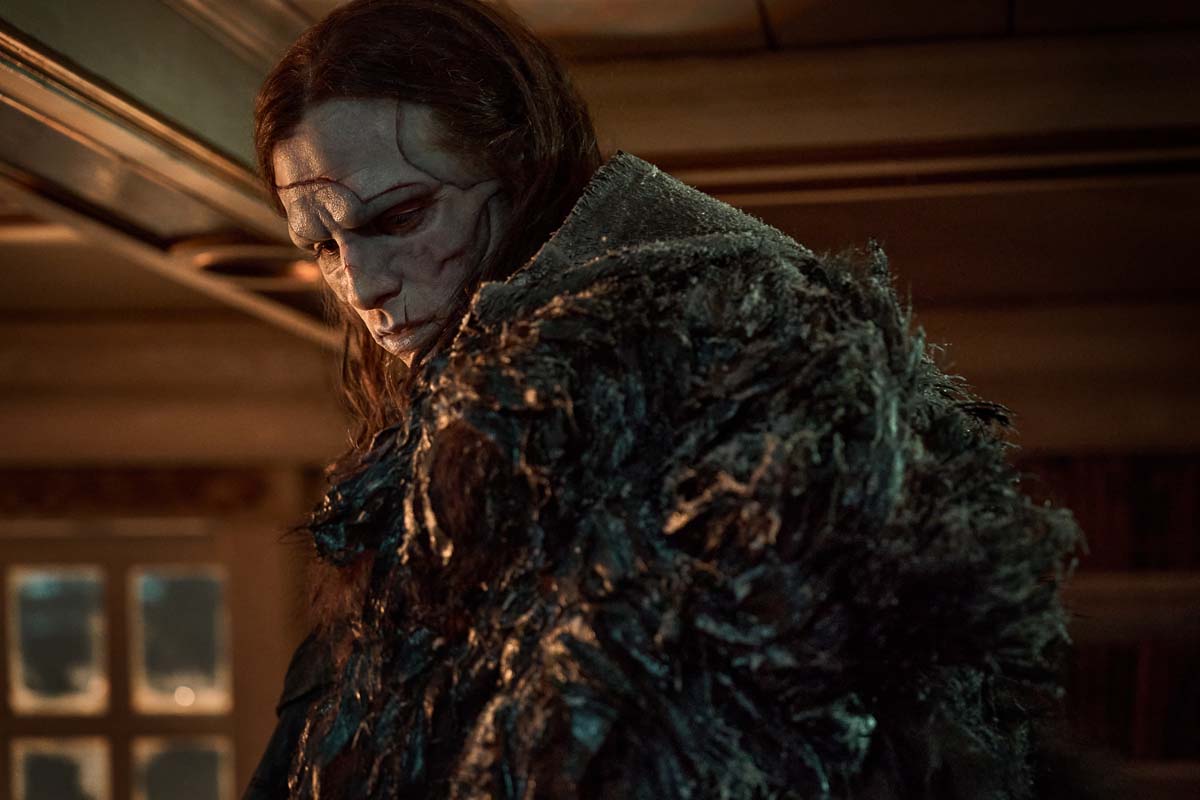
It seemed like so much of it was done in-camera. Did getting VFX changed things: either change timings or change your feelings about shots?
Dennis Berardi, our visual effects supervisor, also the owner of Herne Hill Media, which is our primary VFX vendor, had a crew of people ready to go from day one, and they had all these environments that they’d built in Unreal Engine, so we were getting like background replacements where we need to feel like we’re in the Swiss Alps several days after we shot the initial plates.
And they had lightning and fog and all sorts of environmental things. The speed at which they were able to turn around these temp comps for us was incredible and allowed us to then make editorial changes because of that.
For example, the shot of Victor climbing the tower - once that looks like it’s really high off the ground- now we want a little bit more of it. When you’ve just got a blue screen in there you can kind of guess, but it’s a totally different feeling to see the actual background.
Similarly, we built a practical ship in a parking lot in Toronto, so every scene that’s on the ship is on this actual massive ship that’s in this parking lot, but that ship still needs to be in the Arctic at the end of the filming.
It needs to be pushed out into the water and sail off into the sunrise. That was Dennis and ILM taking all of that and giving us the visuals that we need in order to properly pace the story and tell the story and to show it to people very, very early so that we can get accurate feedback without breaking that suspension of disbelief that you inevitably get whenever you show a rough cut.
Talk to me a little bit about sound in this movie. I wouldn’t call this a horror movie…
It’s not. We call it an epic drama.
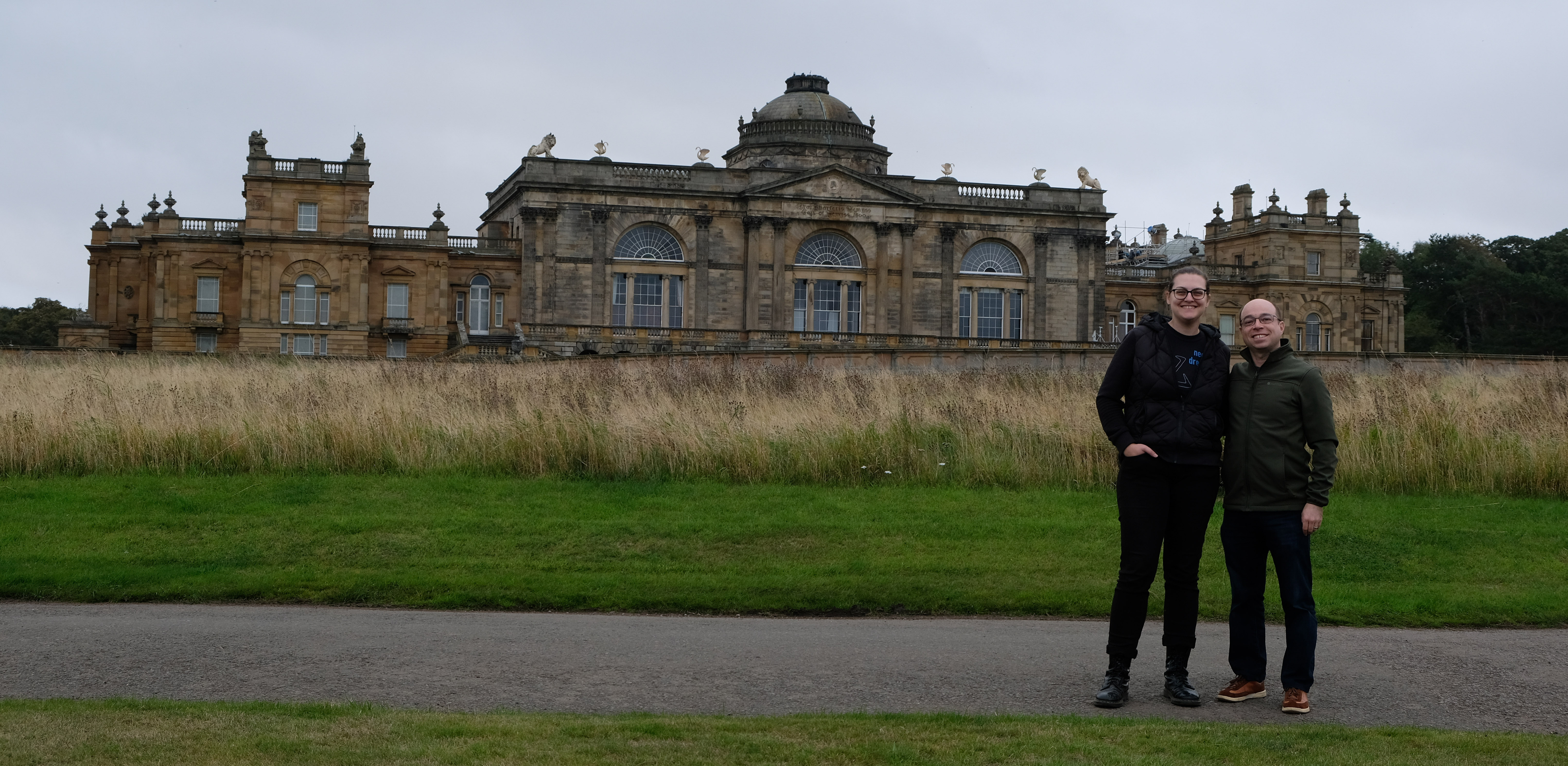
Evan at Gosford House with 1st AE Brit DeLillo.
Absolutely. But horror movies, of course, are very reliant on sound. You would think that this would be.
I am, and have always been, a very sound-aware editor. I was on one of the first teams to do a 5.1 temp mix in Avid Media Composer.
I got a great lesson from Will Files on Star Trek: Into Darkness when I was an assistant editor on sound editing and sound mixing. I’ve carried that all the way through.
And when I work with my assistant editing team everybody collaborates on editing and mixing and working towards this goal of having a very thorough, complete temp track.
In Toronto, I had an assistant editor, Luis Freitas, and trainee assistant editor Braden Sheets. Then when we went to Scotland and England and back for post in LA, I had my usual first assistant editor, Brit DeLillo.
All of them were absolutely amazing at sound editing and mixing. One of the luxuries that we had on this was - because Guillermo has this crew of people in Toronto that he has worked with time and time again - we knew who our sound supervisors were going to be.
And they knew Guillermo. So we had these two guys, Nathan Robitaille and Nelson Ferreira. They weren’t on our movie from the very beginning, but they were available to us. So when we would get things like the ship attack at the very beginning, which we shot early on and was one of those key scenes that we would show to executives or people that we needed to impress during the shoot, we sent that out to Nelson and Nathan to do creature vocals and to give us the sounds of the ship creaking and the ice breaking and the bones cracking.
We do the best that we can in Media Composer, but there’s always that extra step that professional sound editors can do on their end. What you get back from them is so helpful in selling the world of the film.
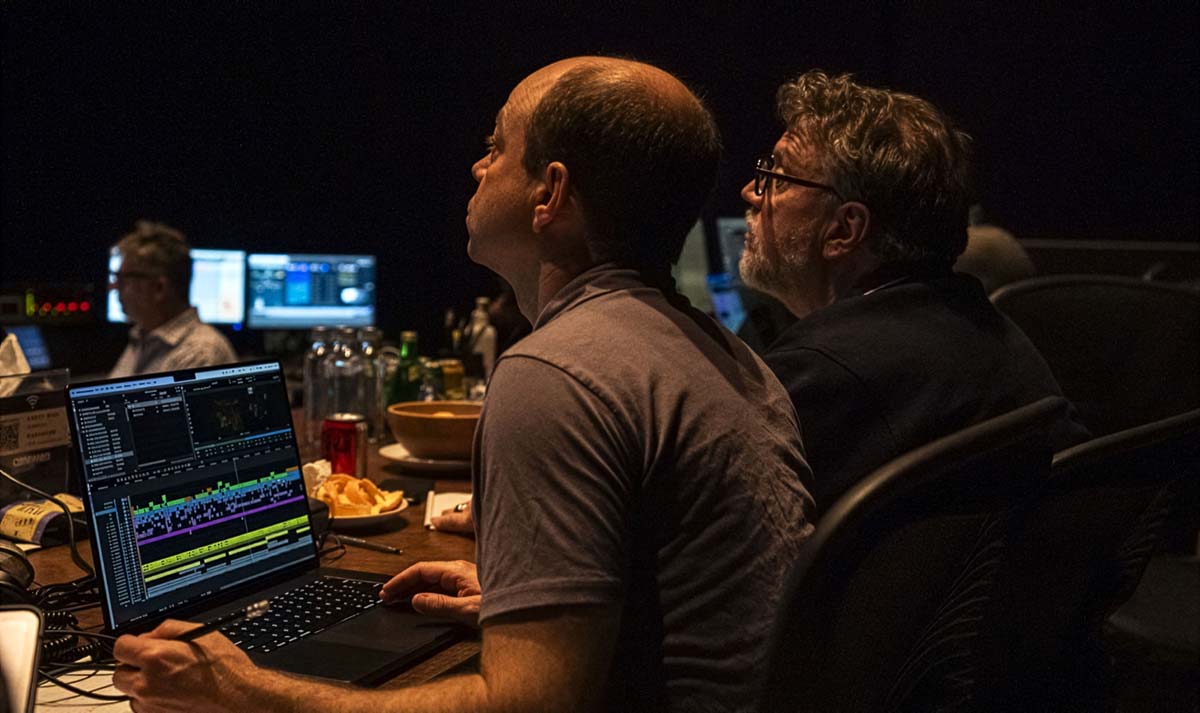
Evan and director Guillermo del Toro on the Mix Stage
Especially if the ship is in a parking lot.
Exactly! And the blunderbuss just has a temp muzzle flash, but it needs to sound like the giant gun that it’s eventually going to be.
One of the great things that Nathan did especially was to subcontract Foley out very early. All the grabs and the cloth movements and footsteps are some of the last things that you normally temp because you kind of get the hard effects first and the backgrounds.
Once you get that first Foley sound effect in there, then any place you don’t have one sounds empty. So we had Foley very early in these key scenes, like the ship attack scene.
The lecture hall scene was one of our other showpiece scenes, which is also a showpiece for me. I loved editing that scene and how that scene came together. There were a few other scenes - like the forgiveness scene was another showpiece scene.
So being able to combine our in-house sound efforts with Nathan and Nelson’s work was really, really useful and helpful for them because they got to start their R&D early on. What should the creature sound like? How much of this guttural sound does the creature need to have?
Are there points where we should hear more of Jacob’s voice and less augmented animal sounds and processing? When does that stuff really need to come front and center? So we were able to start establishing the rules of how the creature sounded really early.
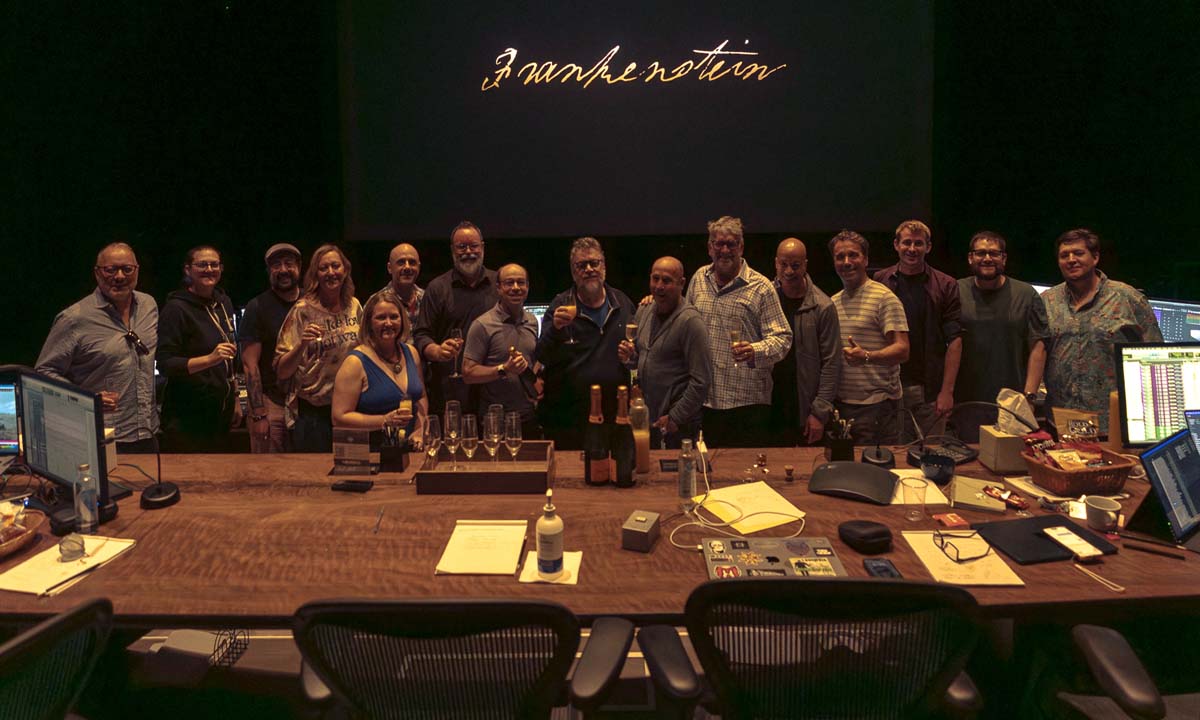
Post team at the Mix Stage
Did you monitor 5.1 while you were cutting this?
We cut and mixed in a 5.1 sequence, but I only had 3.1 in my office. We had 5.1 in a little theater that we had access to in the production office in Toronto, and we had 5.1 in our theater once we got back to LA for post, so we were able to make sure that our mix was good when we were playing it in a 5.1 theater.
Whenever I would send Nathan and Nelson requests to cover a scene, they would send me back 5.1 splits of backgrounds, 5.1 Foley, 5.1 hard effects, then I would get mono or sometimes stereo creature design vocals and any cleaned up dialog that we needed in mono.
We had this great theater at Roundabout in Santa Monica with an amazing giant OLED screen. It’s a Samsung Onyx. It was awesome. We would check our mix in there.
Then around 3 or 4 months into post we went to Universal and Frankie Montaño did a real temp mix using our Avid tracks as a base with a dialogue conform on top of it. So from then on, I had stems in five one from Frankie and carried those through from December until we final mixed in July.
There’s no alternative for me to having good sound. You need to have good sound to show it to people and all that effort of getting quick temp comps and getting sound from Nathan and Nelson and constantly making sure that that we had checked off every item on Guillermo’s editorial plate was all super important for presenting this united front of: “This is the movie. You can imagine very clearly what it’s going to be by the time that we get to the end.”
Getting the final mix and getting Alexandre’s score in there made it feel radically different. Particularly with the sound track, there were no surprises.
They took what we had in that temp that we had worked and collaborated on for so long and took it many levels beyond in the actual final mix, but still all the elements and all the decisions and all the things that we had figured out about what worked and what didn’t work on the sound track became our template as we were going through the final mix in Toronto.
Evan, thank you so much for talking about this movie with Art of the Cut.
